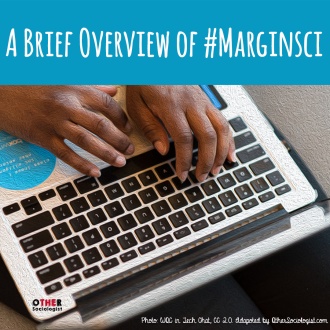Storify is closing and over the coming weeks, I will be migrating my posts to my blog. This is an archive of my article first published on Storify in March 2017.

The hashtag #Marginsci was stared by biochemist/ biophysicist Dr Stephani Page, who was on the March for Science Steering Committee. Dr Page had been an early contributor to thoughtful discussions about exclusion within the march; a commitment she continued after taking up her role within the committee.
This compilation is by no means a comprehensive history of #marginsci. Instead, it provides a background context to the hashtag and a discussion I led on on 5 March 2017, regarding the backlash associated with the hashtag. I also cover the lessons that the March for Science organisers might draw from the activism of scientists using the tag, as well as the efforts of the Women’s March to take an intersectionality approach to their activism.
Below are just some of Dr Page’s first tweets about the march. She connected the exclusion of Black women from in mainstream feminism to what was happening with the march by the 28 January 2017. This was just four days after the March for Science Twitter account was established.
Dr Page went on to share questions she’d posed to her local march regarding representation and to what extent minorities were in decision-making roles.
Subsequently, Dr Page joined the central organising committee in Washington DC, which is also overseeing coordination of the global marches.
On the 3 February, Dr Page discussed how her identity impacts how she does science, and that it’s a privilege for others to think they can dictate science. A couple of weeks later, Dr Page proposed the #marginsci hashtag to bring together various conversations happening across English-speaking global networks on Twitter. Dr Page said that despite being on the committee, she wanted to address the “vile messaging around our place in science, the March for Science and satellite Marches.”
By the 4 March 2017, #marginsci conversations had reached a peak of collaboration, having already addressed various problems with the messaging of the march. Most recently, scientists had used the #marginsci tag to discuss racism by the Los Angeles satellite march.
I discussed the racist push back to these #marginsci efforts. I noted that supporters for the March for Science show greater anger that racism is discussed rather than the actual incidents of racial discrimination. Supporters of the march are also dismissive of their role in combating racial bias, putting the work back on people of colour. Minorities in general were being blamed for potentially “ruining the march.” These are all hallmarks of an environment that is hostile to diversity.
https://twitter.com/OtherSociology/status/838244934171795456
https://twitter.com/OtherSociology/status/838245143001997312
https://twitter.com/OtherSociology/status/838245566089830401
https://twitter.com/OtherSociology/status/838245876279627776
https://twitter.com/OtherSociology/status/838246264345014273
https://twitter.com/OtherSociology/status/838246538837032961
https://twitter.com/OtherSociology/status/838246918165684228
https://twitter.com/OtherSociology/status/838247288766005248
https://twitter.com/OtherSociology/status/838247539648258048
I went over the history of #marginsci, beginning with Dr Page’s activism, and her discussion of intersectionality for the march. (Intersectionality describes how gender inequality is impacted by racism, as well as other social issues such as class, ableism, age, sexuality and beyond.)
https://twitter.com/OtherSociology/status/838250764967395329
https://twitter.com/OtherSociology/status/838251138566647808
https://twitter.com/OtherSociology/status/838251545506398208
https://twitter.com/OtherSociology/status/838252166133342211
https://twitter.com/OtherSociology/status/838252578169200641
https://twitter.com/OtherSociology/status/838252772508090368
I then gave an overview of the history and issues with the Women’s March, which started off as an idea by one woman in Hawaii (Tricia Shook), which was overtaken by White feminists who were exclusionary. Eventually, the Women’s March was led by a team of activists who had a vision driven by intersectionality (Bob Bland, Tamika Mallory, Linda Sarsour, and Carmen Perez). There was still pushback to its inclusive approach to women’s rights, similar to what was happening with the March for Science.
https://twitter.com/OtherSociology/status/838253684228157441
https://twitter.com/OtherSociology/status/838254188542877696
https://twitter.com/OtherSociology/status/838254519632875520
https://twitter.com/OtherSociology/status/838254752546729985
https://twitter.com/OtherSociology/status/838255057057435648
https://twitter.com/OtherSociology/status/838255308312993792
https://twitter.com/OtherSociology/status/838255792088240128
https://twitter.com/OtherSociology/status/838256218657337344
https://twitter.com/OtherSociology/status/838256702734532608
The issues arising in the lead up to, and after, the Women’s March are pertinent to the March for Science. Many #marginsci scientists implored the co-chairs of the March for Science to take on board these previous lessons. The issues included racist dynamics that made women of colour feel unwelcome in community groups, as well as on the day of the march, and lack of accessibility and inclusion of disabled women and transgender women. These lessons are public and should have been an impetus for improvement in the March for Science, especially given the science march is inspired by the Women’s March.
https://twitter.com/OtherSociology/status/838257022986412032
https://twitter.com/OtherSociology/status/838257264674795520
https://twitter.com/OtherSociology/status/838257872161009664
There are vocal, exclusionary elements of the March for Science that have diminished the participation of underrepresented scientists. A social justice movement should not be so dysfunctional. The leadership of the march needs to take a more proactive approach to equity, inclusion and accessibility.
https://twitter.com/OtherSociology/status/838258122820984832
https://twitter.com/OtherSociology/status/838258357924319232
https://twitter.com/OtherSociology/status/838258676292952066
https://twitter.com/OtherSociology/status/838258993822756865
Responses from scientists
Many scientists have voiced their disappointment and frustrations with the March for Science, for being so reticent to commit to basic principles of exclusion. Others saw that the organisers were being too conservative, undermining the purpose of a protest. Although many science organisations have officially endorsed the march, it is unclear as to whether these organisations are aware of the diversity issues arising from the march.
https://twitter.com/OtherSociology/status/838248061495214080
https://twitter.com/MariannePeso/status/838245196009635841
https://twitter.com/notfroggie/status/838235079080050688
https://twitter.com/OtherSociology/status/838289393488048128
https://twitter.com/OtherSociology/status/838289655250313216
https://twitter.com/DrJBacteria/status/838291871143075840
https://twitter.com/OtherSociology/status/838294237456154624
https://twitter.com/OtherSociology/status/838299608056922114
Dr Page picked up on the tremendous amount of unpaid labour underrepresented minorities were doing to help the March for Science be more inclusive.
Chemistry Professor Matthew Hartings likened the reactions to #marginsci to climate change denialism: despite the scholarly data being presented, some supporters of the march were unwilling to listen to the evidence on the need to address diversity in science.
https://twitter.com/sciencegeist/status/838467219931676674
https://twitter.com/sciencegeist/status/838467628096176129
https://twitter.com/sciencegeist/status/838467937753305093
Image credit: Tyler Feder. [Drawing of seven women and femmes wearing the “Rosie the Riveter” headscarf flexing their biceps in the iconic “Rosie” pose. We see a Black woman, a little woman, a slim woman, a femme man, a woman in a wheelchair, a woma hijab and an overweight woman.]


